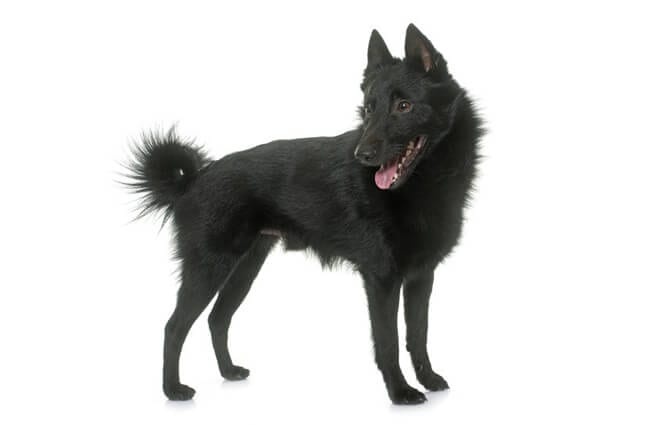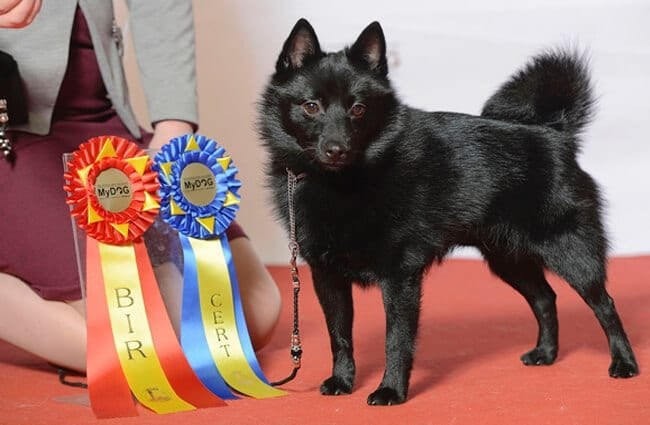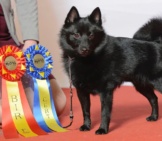The Schipperke, pronounced skip-er-kee, is a ratter that was bred to work on the barges of Belgium. One of the spunkiest dogs out there, this “little captain” will certainly captivate any household that takes him in. He is a mischief-maker, sure to make any worthy owner laugh at his larger-than-life personality, especially contained as it is in such a small package. Read on to learn more about the Schipperke.
Description of the Schipperke
These dogs are unique both in attitude and in looks. They are small, yet sturdy. They have pointed faces and alert ears, on the prowl for anything new and exciting. The Schipperke sort of resembles a tiny lion, although in this case one with no tail.
The Schipperke has extra hair around his neck, shoulders, and thighs. This gives him an odd shape, and highlights his compact size. These dogs are known for their thick black coats, rounding out their distinctive set of characteristics.
Life Expectancy and Size
These small dogs are only 10 to 13 inches tall, and weigh less than 20 lbs. – usually between 10 and 16 lbs. It’s surprising so much spunk can fit into such a little body! The Schipperke should live well into his teens, with a lifespan of between 12 and 14 years.
Protective Ability
This breed is known for its bark. In fact, it can be quite shrill. For this reason, he’s quite a good watchdog. Constantly alert and curious, he will always be at the ready.
However, the Schipperke isn’t exactly a guard dog. Remember: they’re only 10-16 pounds. However, this little dog makes up for his small size with plenty of bluster and barking. It’s very possible that this breed might try to challenge an intruder, even if there’s no chance of winning. It seems that they do know their size, and they make up for it with barking!
Training
The Schipperke can be a fun training challenge – they are alert and fast-moving, keeping their trainers on their toes.
This breed can be quite stubborn, but more than anything is distractible. Keep sessions short and interesting, and use lots of treats or toys to keep them “in the game.” If you’re worried about your little dog’s weight, simply reduce his daily kibble rations in relation to his training treats.
Given their distractible tendencies, it’s best to focus on building your relationship with lots of play, praise, petting, and treats. Correction-based training will make this breed try to avoid you more than anything.
Off-leash obedience tends to be a challenge for these dogs, owing to their high prey drive.
What Living with a Schipperke is Like
Living with a Schipperke is like nothing else. They are mischief makers, but not in a mean-spirited way. Their busy personalities could be described as similar to that of a Jack Russell. However, perhaps they have more genuine curiosity and slightly less terrier cheek.
These dogs can be wary of strangers, as they’re always on the watch for something amiss. Early socialization and exposure to many kinds of people, dogs, and places can help. Regardless, they still might try to challenge things five times their size.
Overall, the Schipperke is an active little dog in a small body. He may not be able to keep up with his owner’s long legs on lengthy runs or jogs. However, he is sure to add vibrancy and spunk to any household that can deal with his big personality.
Care of the Schipperke
Caring for the Schipperke is not so hard as learning to live with the breeds’ quirks. These dogs are hardy and generally easy to care for.
Environmental Needs
This breed has a good amount of hair, which protects them pretty well from the cold. Smaller individuals have more trouble maintaining their body temperatures, and may need limited time outside when it’s cold.
Schipperke can be equally happy in a small apartment or a large house, as long as you don’t mind them racing around either space.
Exercise Needs
Energetic and curious, regular exercise can help these dogs stay healthy and out of trouble.
Simple daily activities are generally all they need. Play sessions in the yard or brisk walks will work just fine. These dogs are not usually able to be off leash, except in very safe areas. Their drive for prey is simply too strong for them to reliably come back.
Even with regular exercise, this dog will most likely be energetic and playful at home. Life is constant exercise for this breed.
Shedding and Grooming
Shedding and grooming is fairly low maintenance. Weekly brushing will help to remove loose hair and dirt, keeping these moderate shedders sleek. Baths do not need to occur more than once a month.
These dogs will shed more heavily seasonally. More frequent brushing will help to remove excess hair, and keep things relatively clean. Of course, they also need the same regular maintenance as all dogs. Consult your vet about any specific concerns.
Ideal Home Environment
The Schipperke’s owners should appreciate the breed’s spunk and humor.
They need to have moderate exercise, and spaces where they can run around at any time of day. As small dogs, they may not be able to keep up with very active owners.
Although kids may enjoy this breed’s personality, these dogs are not good with small children. They do not enjoy being teased or rough housed.
Barking can be an issue, so close neighbors may not be ideal for this breed.
Health Concerns
This breed is pretty healthy.
Common problems are those found in most dogs. Hip and knee problems, eye, and thyroid issues are not uncommon. Working with a reputable breeder can increase the Schipperke’s chance of being healthy and living a full life. Screenings are also advisable.
MPS IIIB is a fatal disease that first shows up as balance issues in young dogs. This too can be screened for.
Behavior Problems
Most problems with this breed arise from their innate curiosity. They may dig out of yards or jump fences in pursuit of their newest prey. These dogs are also known to chase small animals like rodents and cats, which can be a problem for homes with other pets.
Some of these problems can be mitigated by keeping Schipperkes occupied and stimulated. Close supervision and obedience training can also help. Discuss any serious behavioral issues with a specialist.
























![Red Angus Closeup of a beautiful Red Angus cowPhoto by: U.S. Department of Agriculture [pubic domain]https://creativecommons.org/licenses/by/2.0/](https://animals.net/wp-content/uploads/2020/03/Red-Angus-4-100x75.jpg)

